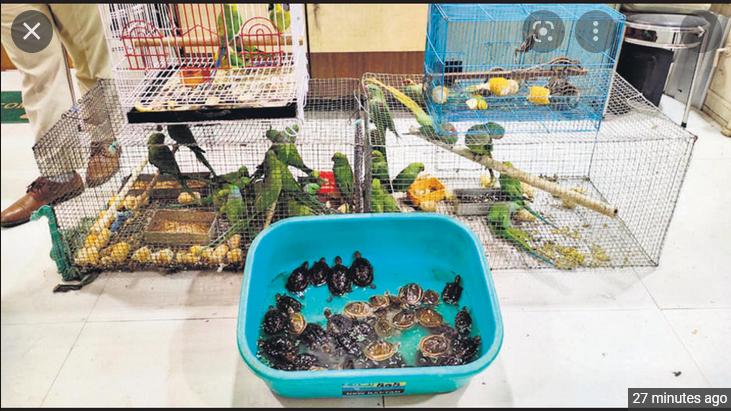Africa-Press – Gambia. There were cages and wooden crates inside the dark and damp storeroom. As the door creaked open, a pungent smell filled the air. The cages were not unusual, and neither was the stench. It was, after all, Aizawl Zoo on a hot summer afternoon.
The contents of the cages were, unfortunately, no longer unusual either. On May 8, this particular consignment was seized from Khankawn near the Mizoram-Myanmar border. Inside were kangaroo rats, meerkats, white cockatoos and Burmese pythons, exotic animals that should never have been in India. Kangaroo rats are native to North America, meerkats to southern Africa, and the Burmese python to south east Asia.
The zoo attendant quickly shut the door. There were instructions to restrict access to the room.The animals were glaring evidence of a flourishing exotic animal trade that exists in India and emanates from the northeast. This seizure was just one among several over the past few months.
On the same day when this consignment was seized in Mizoram, more than a thousand kilometres away, in West Bengal’s Jalpaiguri, district officials seized four Javan Lutung monkeys, a pair of Mona monkeys from western Africa, and a Red Shanked Douc, native to Vietnam and Cambodia, from a bus bound for Siliguri.
Two days later, in Assam’s Rangia, another consignment containing two African crested porcupines were seized, and four people arrested. More famously, on April 1, villagers in West Bengal’s Jalpaiguri district were stunned to spot two emaciated kangaroo’s on the side of the road at Gajoldoba, a tourist destination near Siliguri. A third kangaroo was spotted near Farabari, 40km away, while another was found dead.These seizures were just the tip of the iceberg, an official of the Wildlife Crime Control Bureau (WCCB) said. “What may seem like stray, separate incidents are actually the result of an organized racket with international links, constantly feeding the Indian pet industry,” he said, requesting anonymity.
HT travelled across three states — West Bengal, Assam and Mizoram — where this string of seizures have been made to unravel a burgeoning industry, porous borders and lax laws that facilitate their entry.
Modus operandi
On March 12, when officers of Kumargram police station in Alipurduar district in north Bengal began investigating a case in which a kangaroo was seized from a truck, they stumbled upon the name of the Buennel Farm, reportedly owned by a man named Thagtee in Mizoram.From the driver and the helper, they found a transit permission letter and a purchase order signed by the curator of the Kamla Nehru Prani Sangrahalay, also known as the Indore Zoo, in Madhya Pradesh.
“One red kangaroo was being donated to us by a man named Thagtee based in Mizoram,” said Nihar Parulekar, curator of the zoo. “The document signed by us says animals must be from a legal source of procurement and with necessary documents. We would have had to produce these to the Central Zoo Authority after receiving the kangaroo.”
And yet, Ritu Raj Singh, the then Chief Wildlife Warden of Mizoram, confirmed to HT that Buennel Farm and Thagtee were fake names, and no such farm existed. “The authorities in West Bengal had contacted us. We checked, but there was no such farm in Mizoram. There was no address given,” Singh said. “We believe they were fake names, both the person and the farm.”International dead end
Typically, as in most such cases, investigations hit a dead end. The arrested driver and helper could only tell police they had received the consignment from Guwahati and was taking it to Indore. WCCB officials and forest officials from Mizoram believe the consignment had come from across the international border.
“In most cases, investigating agencies hit a dead end primarily because the chain is highly fragmented. The persons arrested are just transporters and carriers and do it for easy money,” a Mizoram forest department official said, declining to be named. “The link invariably leads across the international border and transborder investigations are a huge bottleneck.”
In another such case, on May 11, forest officials in Assam’s Rangia intercepted a container carrying scrap paper. Hidden inside were two cages carrying two African crested porcupines. Four people were arrestedIt is a relay. Two people went to Mizoram, received a consignment from another team and brought that to Guwahati, where it was handed over to a four-member team. This was supposed to be handed over to another team at Moradabad in Uttar Pradesh,” another forest official said. “This is a deep-rooted network and they remain connected over phone.”
Further investigations showed that one of the four arrested was a serial offender. In the past three months, he had travelled to Guwahati and Mizoram at least five times to receive consignments, such as Capuchin monkeys or African wild dogs, the official said on condition of anonymity.
These animals are largely entering India’s borders from countries like Thailand, Indonesia and Myanmar, where there are exotic animal breeding farms, WCCB officials investigating such cases said.These are likely feeding the illegal trade through the northeast. The animals are being brought to Myanmar, after which they cross the India-Myanmar border, particularly through Mizoram,” said Agni Mitra, deputy director of the eastern region at WCCB.
Once in India, they reach Assam and West Bengal, and are then funnelled through to their demand destinations across India. “The animals are crammed into small cages to be transported in trucks and buses. A tiny cage often carries three monkeys and dozens of birds. Many die en route, and those that are alive are nearly always in very poor health,” said a forest official in Assam who seized such a consignment.
Environmental consequences
The illegal exotic animal trade in India is servicing an ever growing pet industry, experts said. In fact, the Directorate of Revenue Intelligence Smuggling in India Report 2019 flagged this and said: “There is an unfortunate and increasing trend in smuggling of endangered and exotic fauna from different parts of the world into India. Most of these land up as exotic pets. Since there is a complete ban on trade in Indian species, interest of the smugglers has shifted to exotic species, which has led to disastrous global environmental consequences.”There have been suggestions that zoos may also be involved in the racket, a police officer in West Bengal said, declining to be named. “It is likely that private collectors order exotic animals through a zoo. The zoo is offered money to issue a transit letter. If the consignment is seized, the zoo will have the option to say that it was being brought on donation,” he said. “If it manages to pass through the naka (check post) of enforcement agencies, it goes straight to the private collection.”
“In the past too, lion and leopard cubs, chimpanzees, iguanas and exotic birds have been seized. There has been a continuous influx through the northeast and through various ports and airports,” said Tilotama Varma, additional director of WCCB in New Delhi.“But over the past few years sensitization of enforcement agencies such as Border Security Force, Sashastra Seema Bal and Directorate of Revenue Intelligence has led to increased number of seizures.”
Why smuggling has become easier
The 1,643km unfenced, porous India-Myanmar border that runs through four states — Arunachal Pradesh, Nagaland, Manipur and Mizoram — has always been a hub for smuggling.
Between 2018 and 2020, at least 1,629 smugglers were apprehended along the border, the highest in the country, significantly higher than the 1,029 along the 2450km India-Nepal and India-Bhutan borders put together, junior home minister Nityanand Rai told Lok Sabha in August 2021.
International politics could have exacerbated an already dangerous situation. In February 2021, a military junta seized control of Myanmar, jailing National League for Democracy leader Aung San Suu Kyi, triggering widespread protests, armed resistance and mass killings.The border, which was already porous, has become more so now,” said a senior police official of Champai district in Mizoram who declined to be named. “People are in desperate need of money and traffickers are taking advantage of this. Smuggling provides easy money.”
Prior to the coup, there were meetings between WCCB officials in India and their counterparts in Myanmar to share data and inputs on wildlife trafficking. “These were annual meetings,” said a WCCB official. “Unfortunately, these meetings have stopped after the turbulence in Myanmar, and over the last two years, there have been none.”
One key aspect is the one-time voluntary disclosure scheme announced by the federal environment ministry that allowed owners of exotic live species acquired illegally, or without documents, to declare their stock between June and December 2020.As a first step towards developing an inventory of exotic animals in India, the ministry introduced the scheme to streamline compliance with the Convention on International Trade in Endangered Species. Owners were meant to declare the animal without declaring the source, after which the state chief wildlife warden would issue a certificate.
The disclosure scheme introduced in June 2020 may have had untoward consequences, some officials believe. “After the scheme was introduced, many consignments were intercepted, looking to take advantage of the amnesty,” an official of the West Bengal forest department said.
An environment ministry official, however, denied that the disclosure scheme had any role to play. “The deadline for the VDS is long over,” he pointed out, seeking anonymity. “It shouldn’t be an issue now as there is no question of any more time being given.”Another factor affecting illicit wildlife trade, officials said, is the free movement regime inked between India and Myanmar in May 2018. The agreement allows tribal people living in India and Myanmar to travel up to 16km into either side without visa restrictions and on a simplified permit issued by local authorities for up to two weeks.
As on May 9, more than 1,600 Myanmarese nationals were staying in India under the programme, data compiled by the Assam Rifles showed. In Mizoram in particular, there are over 250 villages with around 300,000 people living within 10km of the border, who frequently cross the international border.
“The FMR was meant to regularize free movement and promote trade and cultural ties. But miscreants on both sides of the border regularly take advantage of this to smuggle in drugs, arms and even animals,” said Lalrinsanga, a local resident of Zokhawthar, a border town in Mizoram.The inefficacy of the law
On March 12, when the driver of the truck, SK Javed, and his helper, SK Imran, were arrested for smuggling the kangaroo in West Bengal, they were charged under sections of the Prevention of Cruelty to Animals Act, which is bailable and carries a maximum punishment of three months in prison and around ₹100 fine. This, officials said, was symptomatic of the weakness in Indian law.
“Unfortunately, the Wildlife (Protection) Act 1972, the foremost legislation in India for the protection and conservation of wildlife, is silent about exotic animals,” the West Bengal forest department official said. “As a result, if consignments are seized close to an international border, the accused are booked under the Customs Act. If they are caught deeper in the mainland, they are booked under Prevention of Cruelty to Animals Act.”There is no law which explicitly mentions exotic species, said Jose Louies, joint director at the Wildlife Trust of India. “Unlike animals found in India, exotic species are not listed in the Wildlife (Protection) Act 1972. However, an amendment has been proposed (to increase the penalty to ₹75,000 and five years imprisonment). If it is enacted, it will hopefully add some teeth to the law,” Louies said.
“Currently, exotic species are governed by CITES to which India is a signatory. As CITES is an international agreement, its implementing authority in India is the customs department,” Louies added. “But once it crosses the border and comes into the country, CITES doesn’t apply. The person can then only be booked under the Prevention of Cruelty to Animals Act, which is a very weak law.”The new draft legislation, which has been sent to a joint parliamentary committee led by Jairam Ramesh of the Congress, intends to include CITES species under scheduled IV of the Wildlife (Protection) Act.
At zoos across India, however, the exotic animal industry has brought another problem to the fore. Once seized, these animals are sent to the nearest zoos for safekeeping. Over the past few years, the Kolkata Zoo has received red billed toucans, kangaroos, chimpanzees, capuchin monkeys and marmosets. Last year, the Guwahati Zoo had to arrange food for marmosets through a contractor.
Back at the Aizawl zoo, there was an existential crisis of sorts. The dank room was fast filling up. “If this trend continues, we might have to increase the number of cages because we are fast running out,” an Aizawl zoo attendant said.
For More News And Analysis About Gambia Follow Africa-Press






